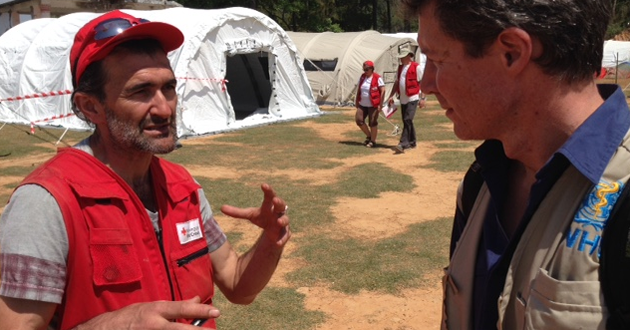
WHO/P. Garwood
Working side-by-side to treat the injured, heal the sick, and deliver babies, Nepali medical staff and international teams are striving to deliver health services in the earthquake-ravaged district of Sindhupalchok.
In the district capital of Chautara, around 320 kilometres northeast of Kathmandu, the main hospital was badly damaged by the 25 April earthquake. WHO with the support of foreign medical teams, including the Norwegian Red Cross, stepped in. They arranged for the deployment of a 60-bed mobile medical unit to deliver a wide range of essential health services, from treating wounds and setting broken bones to delivering babies and dispensing medicines from a well-stocked pharmacy.
‘Worst affected district in Nepal’
“The Sindhupalchok district is the worst affected in all of Nepal, with over 2000 people dead and many more injured,” says Dr Elena Mulmi, a medical officer from Chautara District Hospital. “Our entire hospital was totally damaged and we shifted here,” she adds, pointing to a series of tarpaulins and other makeshift shelters that serve as clinics. The temporary structures include a large rainbow-coloured big top, dubbed the ‘circus tent’ by locals.
“We were unable to bring all the equipment from our hospital for wound dressing and sutures. But the new mobile hospital is well equipped. They are planning for orthopaedic surgery and have taken some of our patients already,” she explains. “I think the people from Sindhupalchok will benefit a lot from this hospital.”
The Norwegian Red Cross team deployed a large team to Chautara, including doctors, nurses and logisticians. But Ranveig Tveitnes, deputy team leader of the mobile hospital, says the critical ingredient is the teaming up with the area’s local health staff.
“The Nepali doctors worked in a nearby makeshift clinic for the first week after the earthquake, and they did a fantastic job,” she says. “Now they are integrating with us. Their doctors and nurses are working with ours. Their pharmacist is in charge of our pharmacy. We are working as one team.”
Challenges of setting up a new mobile hospital
Ranveig says her team encountered several challenges setting up the new mobile hospital. They had to wait several days for their equipment and medical supplies to pass through the congested Kathmandu airport, which has seen an enormous increase in traffic since the earthquake. And delivering the materials to the remote Chautara township meant navigating rubble-covered roads that snake through the mountainous region. “But we managed. We did a lot of road clearance, and it took a bit longer than expected to get here, but it is an earthquake, so what do you expect?” she asks.
The mobile hospital expects to treat more than 150 patients daily. Health problems will include hygiene and sanitation concerns, the risk of communicable disease outbreaks, including diarrhoeal diseases, as well as the difficulty of reaching remote regions.
Close co-operation between Nepali and foreign teams is crucial
Coordination of the various medical teams – Nepali and international – is key, says Dr Ramesh Vikram Singh, Director of Health for Nepal’s Central Region, which includes Sindhupalchok district. “Many health facilities are damaged and daily hospital services have been interrupted. This is a big problem,” says Dr Singh, standing in the shadow of the damaged district hospital. “Now the challenge is the damage of the peripheral health services.”
Addressing this problem will need continued close collaboration between Nepali and foreign teams, according to Dr Ian Norton, head of the WHO Foreign Medical Team initiative. He believes it is crucial to combine Nepali expertise and local knowledge, with the skills, logistics and experience in emergencies of the Norwegian Red Cross.
“What we will start to see soon is one single team – Nepali and Norwegian Red Cross - working together in Chautara and branching out to villages around,” says Dr Norton, while inspecting the mobile clinic.
Such teamwork will be vital ahead of the approaching monsoon season, where disrupted hygiene and sanitation systems will increase the risk of incidence of communicable diseases, including diarrhoea. WHO is boosting its own presence in the district, sending additional staff as part of the UN-system response to humanitarian needs in Sindhupalchok.
